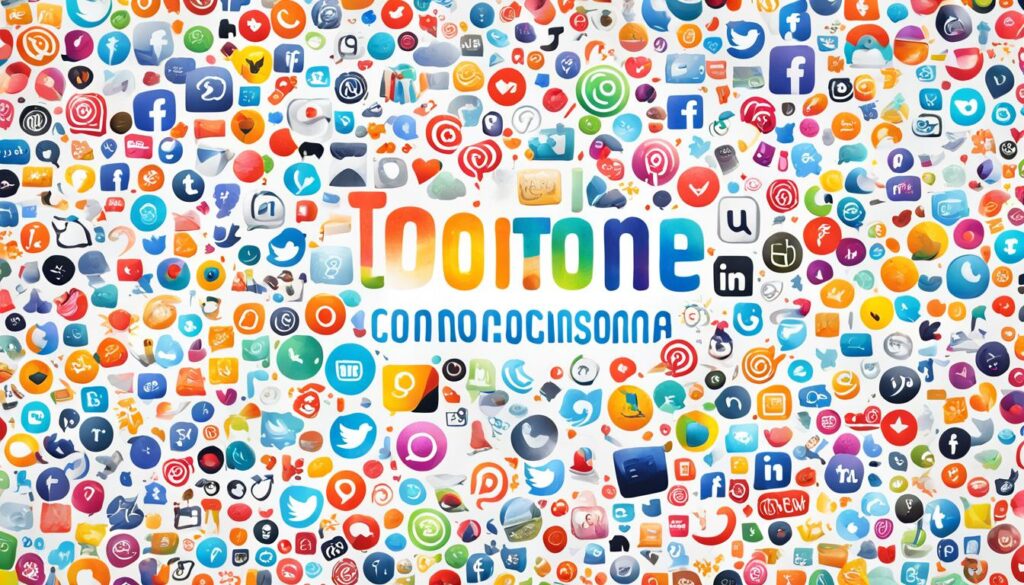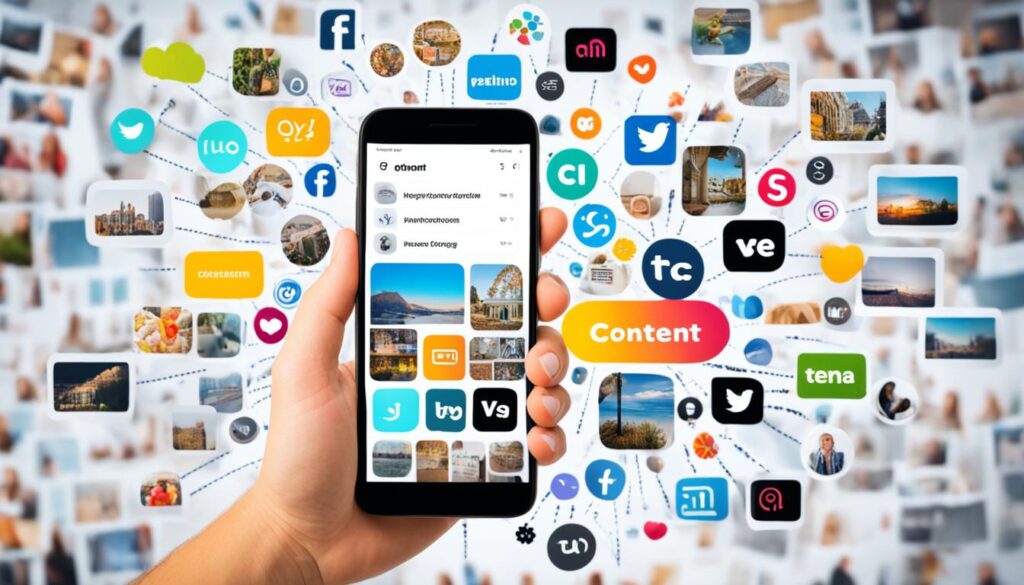Ever wonder why some brands connect better with their audience? It’s often because they use user-generated content well. This strategy has changed marketing. It offers real and relatable material, especially for Gen Z and millennials.
Unlike traditional marketing, user-generated content (UGC) is a budget-friendly way to improve brand connection and trust. It uses customer experiences shared on social media and reviews. This helps build a strong community around what the brand offers. It boosts sales and grows the brand over time.
Key Takeaways
- User-generated content strategy offers authentic marketing material.
- UGC can significantly build trust and influence purchasing decisions.
- Gen Z and millennials highly value authentic customer experiences.
- Brands can gather UGC through social media campaigns and incentivizing reviews.
- Leveraging user-generated content can propel brand growth and enhance engagement.
What Is User-Generated Content?
User-generated content (UGC) is content made by a brand’s followers, not the brand itself. It includes social media posts, online reviews, and videos. It lets brands share authentic stories from their users.
Definition and Examples
UGC is a big part of marketing today. It’s made by the users of products or services. This content is shared widely, showing many different perspectives and experiences.
For example, Coca-Cola let people put their names on bottles. This created a lot of content. GoPro uses #GoPro to share user videos, creating a strong connection with their audience.
Types of User-Generated Content
There are many types of UGC, each with its own benefits. Some include:
- Social Media Posts: From pictures to status updates on Instagram, Facebook, and Twitter.
- Online Reviews: Comments and ratings on sites like Yelp and Amazon, giving honest feedback.
- Blog Posts: Articles on blogs that explore different user experiences with products or services.
- Videos: Clips on platforms like YouTube and TikTok, showing how people use products in real life.
These UGC types boost brand interaction. They give a true look at how customers use and feel about products. Many companies use UGC to earn trust and grow their communities.
| Type of UGC | Platform | Benefit |
|---|---|---|
| Social Media Posts | Instagram, Facebook | Enhances visibility and authenticity |
| Online Reviews | Yelp, Google Reviews | Influences purchasing decisions |
| Blog Posts | Personal or professional blogs | Provides in-depth product insights |
| Videos | YouTube, TikTok | Showcases real-life applications |
The Benefits of User-Generated Content for Brands
User-generated content (UGC) gives brands a big boost. It helps build consumer trust, shows a real brand image, and makes content marketing easier.

Building Trust and Authenticity
Now, more than ever, consumer trust is critical. UGC brings an authentic brand image that connects well with customers. Real user photos and reviews help others trust the product. This trust leads to more sales.
Cost-Effective Content Creation
UGC is a budget-friendly choice for content marketing strategies. It cuts down the need for expensive production. Brands can use user content without spending a lot. This saves cash and brings in fresh, creative posts.
Enhancing Customer Engagement
UGC is great for making community building and boosting customer engagement. By asking users to share their stories, brands can connect better with their audience. This interaction turns customers into a community that supports the brand long-term.
How to Encourage User-Generated Content
Brands can build a strong flow of user-generated content (UGC) by creating platforms that welcome UGC. They can also run UGC campaigns on social media. Engaging users through these methods helps boost the amount and quality of content. It makes the brand more visible too.
Incentivizing Customer Reviews
Encouraging customer reviews can get people talking about your brand. Give them real perks, like discounts or a chance to shine on your official channels. These bonuses encourage happy customers to share their experiences, which attracts others to your brand.
Running Social Media Campaigns
Exciting social media UGC campaigns can lead to more content. Use specific hashtags to gather this content and get people involved. This approach has worked well for brands like Starbucks, bringing more visibility and community spirit through their campaigns.

Engaging with Users on Multiple Platforms
Engaging with customers across many platforms makes everyone feel heard. By being active on various social media and review websites, you create a vibrant community. Responding to questions, highlighting praise, and sorting out issues quickly not only helps users but also encourages them to keep creating content.
Learning these UGC best practices helps brands create a solid user engagement and content strategy. Here’s a quick rundown:
| Method | Action Steps | Benefits |
|---|---|---|
| Incentivizing Reviews | Offer discounts, exclusive content, features | Motivates customers to share experiences |
| Social Media Campaigns | Use specific hashtags, engage followers | Increases visibility and community interaction |
| Multi-Platform Engagement | Interact on forums, review sites, and social media | Ensures user voices are heard and valued |
Effective Strategies for Collecting User-Generated Content
To get the most out of user-generated content (UGC), brands should use smart collecting strategies. They should use tools that make collecting UGC easier. This allows companies to use real content to boost their marketing.

Using Social Listening Tools
Social listening for UGC means keeping track of when people talk about your brand online. Platforms like Hootsuite and Brandwatch help spot content that your audience likes. This not only gives quick feedback but also helps create a stronger bond with followers.
Creating Brand-Specific Hashtags
Using unique hashtags is a great way to collect UGC. These special hashtags make it easy for customers to share their stories. Nike’s #JustDoIt campaign is a good example. It made sorting through UGC much simpler.
Leveraging Review Sites and Forums
Review sites and online forums are full of UGC. Places like Yelp and TripAdvisor share what customers really think. They help brands learn what they’re doing well and what they need to work on. This feedback is key to improving and winning over more customers.
- Use social listening tools to keep track of brand mentions.
- Create and promote brand-specific hashtags for easier UGC collection.
- Look to review sites like Yelp and Google Reviews for genuine feedback.
By using these UGC collection methods, brands can build a powerful collection of content. This not only helps the brand grow but also creates a stronger bond with their audience.
Leveraging User-Generated Content for SEO Benefits
User-generated content (UGC) boosts a brand’s SEO by attracting more visitors naturally. It helps growing organic traffic. UGC enhances a brand’s authority and reach as people create and share content.
Boosting Organic Traffic
UGC directly leads to more visitors coming to a site naturally. This happens because UGC adds new, keyword-rich content. Search engines like sites that are always getting new content from user involvement. The different voices make content easier to relate to, which keeps people engaged and drives organic traffic.
Enhancing On-page SEO
Adding UGC to places like product pages and blogs improves on-page SEO. Things like user reviews refresh your site’s content, pleasing search algorithms. This effort grows user interest and lifts your spot in search results.
Increasing Backlinks
Users often link back to a brand when they share UGC, creating backlinks. These backlinks tell search engines your content is valuable. So, focusing on UGC can give your site more credibility and visibility.

Using UGC well for SEO keeps content fresh and engages your audience. It helps your brand stand out by drawing more visitors, improving specific page components, and getting more valuable backlinks regularly.
| SEO Benefits | User-Generated Content Impact |
|---|---|
| Organic Traffic Increase | Fresh, keyword-rich UGC boosts search engine rankings and engagement. |
| On-page SEO Enhancement | Incorporating reviews and testimonials improves content relevance. |
| Backlink Generation | Shared user content frequently links back to the brand’s site, increasing authority. |
Utilizing User-Generated Content in Marketing Campaigns
Using user-generated content (UGC) lets brands show real customer stories. It builds trust and makes marketing more relatable. People resonate with content created by others like them.
Featuring UGC in Social Media Posts
Putting UGC in social media posts helps get followers involved. It lets brands share real customers’ photos and stories. This builds a sense of community and encourages more people to interact.
It also helps in spreading the word through genuine advocacy of the brand.
Incorporating UGC in Email Marketing
Using UGC in email boosts how many people open and click them. Including customer photos and reviews makes the message more trusted. This approach is trustworthy and can convert more sales.
Displaying UGC on Your Website
Adding UGC to your website improves how visitors see your brand. Placing customer stories and reviews on product pages aids buyers in making decisions. It also increases how much they engage with the site.
| Channel | UGC Integration Method | Advantages |
|---|---|---|
| Social Media | Featuring photos, videos, and testimonials | Boosts engagement and community feel |
| Email Marketing | Including customer reviews and images | Higher open and click-through rates |
| Website | Displaying testimonials on product pages | Increases trust and conversions |
Legal and Ethical Considerations for Using User-Generated Content
The legal usage of UGC is critical. Brands must understand and follow rules to prevent issues. Getting creator permission first helps avoid legal problems. This approach also keeps the relationship positive with their audience. It’s key to respect content rights and give proper credit to the original creators. This action not only meets ethical expectations but also builds trust and goodwill.
Also, UGC ethical considerations must be addressed. This makes sure the use of user-generated content meets ethical standards. Being clear and honest shows respect for the creators. This can lead to a more supportive community. Here are some important guidelines to keep in mind:
- Always seek explicit permission before using any user-generated content.
- Clearly outline the intended use of the content to the creator.
- Honor the original creator’s intellectual property rights by providing credit.
- Establish transparent guidelines around the usage of UGC to build trust.
Implementing these suggestions helps brands work with UGC in a responsible and ethical way. This ensures a respectful and legal use of the content.
Let’s look at a table that lists important steps for using UGC ethically and legally:
| Action | Description |
|---|---|
| Request Permission | Contact the creator to get permission and explain plans for use. |
| Provide Credit | Give proper credit to the original creator always. |
| Respect Content Rights | Know and follow intellectual property laws. |
| Transparency | Have clear and honest talks with UGC creators. |
Following these steps allows brands to use UGC in an ethical and legally secure manner.
Challenges in User-Generated Content and How to Overcome Them
User-generated content (UGC) is great but has its own hurdles. Brands need to tackle these to keep their image sharp and impact strong.
Ensuring Content Quality
Keeping UGC quality high is key for brand reputation and trust. Guidelines and standards help contributors make content that’s top-notch. Moderation tools sift through content, showing only the best. This keeps the brand looking good.
Managing Negative Content
Bad UGC is bound to happen. Dealing with it well means talking and being honest with customers. This turns bad stuff into helpful feedback.
Replying to bad UGC the right way boosts loyalty. It might even turn those unhappy folks into fans.
Maintaining Brand Alignment
When UGC doesn’t match a brand’s values, problems show up. To fix this, brands should be clear and monitor UGC. This ensures content fits the brand’s story. Guidelines and tools help select content that’s just right. This keeps the brand’s message spot on.
These solutions help brands work through UGC issues, making them platforms for growth and better connections with customers.
Best Practices for Showcasing User-Generated Content
To showcase user-generated content well, focus on the best pieces. These should match your audience’s tastes and your brand’s values. A good UGC story or a product’s benefits can deeply involve and motivate your customers.
Update your featured content often to stay fresh and appealing. This keeps people interested and shows your brand is always relevant. By choosing UGC that really fits your brand’s image, you show your offering is reliable and relatable.
Showing UGC in important areas like websites and social media helps your brand’s image. Careful curation shares various customer stories, building a stronger bond with your market. This approach, which emphasizes top user stories aligning with your brand, greatly improves how your UGC is perceived.
FAQ
What is user-generated content?
How can brands leverage user-generated content for growth?
What types of user-generated content are there?
What are the benefits of user-generated content for brands?
How can brands encourage user-generated content?
What are some effective strategies for collecting user-generated content?
How does user-generated content benefit SEO?
How can UGC be utilized in marketing campaigns?
What are the legal and ethical considerations for using UGC?
What challenges are associated with user-generated content and how can they be overcome?
What are the best practices for showcasing user-generated content?
Source Links
- https://medium.com/@antonio.productmgt/how-to-leverage-user-generated-content-in-product-led-growth-4d18936cb596
- https://www.forbes.com/sites/forbescommunicationscouncil/2020/10/14/14-smart-ways-to-leverage-user-generated-content/
- https://www.linkedin.com/pulse/how-leverage-user-generated-content-chad-wyatt-df4qe


Leave a Reply